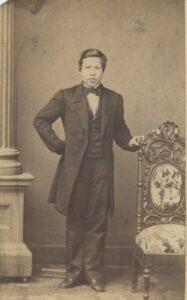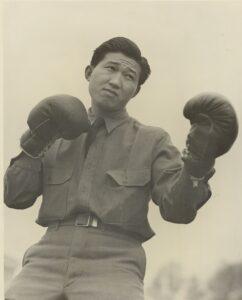Pathways of Persistence: A Collaboration Between LancasterHistory and Lancaster Asian Americans and Pacific Islanders
A successful museum exhibit does more than display images and artifacts—it weaves together the threads of local history, personal narratives, and shared experiences to create something meaningful for contributors, visitors, and curators alike. It was a true pleasure to work with Lancaster Asian American and Pacific Islanders (LAAPI) on Pathways of Persistence, the exhibit currently on display in the Stoudt Gallery.

The relationship between LancasterHistory and LAAPI began when LAAPI included the story of Hong Neok Woo in the proclamation for AAPI Heritage Month which they submitted to the county in 2023. Mr. Woo was an immigrant from China who arrived in Lancaster in 1855 and stayed until 1864. There are two photographs of Mr. Woo and several publications about him are in the LancasterHistory collection, and we were thrilled for them to be a resource for LAAPI as they explored the history of Asian Americans in our community.
Last fall, we began working with Libby Ethridge and Amie Bantz of LAAPI on Pathways of Persistence. The selection of the photographs for the exhibit happened in two ways. First, Amie and Libby put out a call to LAAPI members for photograph submissions. Several of the submissions were photographs taken by Bri Nguyen at LAAPI events. Several more came from LAAPI president Cindy Lam Guo and her husband Xiang Sam Guo who shared images of themselves and of Sam’s father as a young man not long after he immigrated to Lancaster from China in the 1990s.
In addition to the group’s submissions, Libby and Aimee also searched through LancasterHistory’s database for images of Asian Americans that were already in the collection. Though AAPI history hasn’t necessarily been collected intentionally in the past, Asian American stories do appear because Asian Americans have been part of our community since at least the mid-19th century when Hong Neok Woo arrived here.
The first image they chose was a photograph from the 1940s of How Gum, a Chinese American boxer who came to Lancaster for a boxing match in 1941. It was an image they chose because it defied stereotypes of Asian American men. Likewise, they chose an image from the 1980s of a group of Vietnamese American students from McCaskey High School getting ready for prom. Amie told me that it reminded her of the feeling she got when watching the film Crazy Rich Asians. Asian and Asian American women haven’t traditionally been the leads in Hollywood movies, so they seldom get the signature fashion montage that white women get in romantic comedies. In Crazy Rich Asians and in this photograph, they finally got that opportunity, offering new representations of Asian Americans in popular media.

We recently hosted a group of eighth graders from Ephrata Middle School and they, too, were drawn to these two photographs. Commenting on How Gum, one of the students read the image metaphorically, suggesting that the image looked like the man was fighting against racism and prejudice. It was an insightful comment that both echoed the observations of Amie and Libby and read the image in context of the exhibit as a whole. Next to the image of How Gum is a display case that showcases a collection of materials donated by Juila Cao which document the creation of LAAPI in 2021. Lancaster Asian Americans & Pacific Islanders fosters solidarity, though it arose from adversity. People in this community have long faced discrimination and xenophobia, and the Covid-19 Pandemic brought a new wave of attacks because of an association between Asian Americans and the origins of the virus in China. The hardship of this backlash and events like the 2021 Atlanta spa shooting inspired AANHPI (Asian American Native Hawaiian and Pacific Islander) people in Lancaster to come together to share their struggles and bond over their common experiences. Julia staged demonstrations and a vigil in Penn Square with the rallying cry “Stop Asian Hate” which appears on posters and a t-shirt in the exhibit. The exhibit is about fighting against racism and prejudice, even if How Gum’s pose was that of a boxer, not an activist.
It was a privilege and a pleasure to work on this exhibit with Libby, Amie, and LAAPI. Community-driven efforts like this are the heart of LancasterHistory’s work, and, for me, it’s why our work matters. Pathways of Persistence will be on display through the end of May (which is AAPI Heritage Month!). I hope you’ll stop by to see it! LancasterHistory Members always visit exhibitions for free.
From Object Lessons
